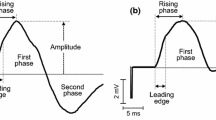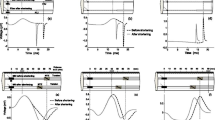Abstract
Intra- and extracellular action potentials of isolated frog muscle fibres were recorded at different distances to the end of the fibre. The first and second time derivatives of the intracellular action potentials were also recorded. The intracellular action potentials and their first and second time derivatives were almost the same regardless of the place of recording. With the decrease in the axial distance to the end the extracellular action potentials changed gradually in a complicated manner from a shape similar to the second time derivative into a shape similar to the first time derivative. Extracellular potentials, having two negative maxima, were recorded over the terminal taper part of the fibres.
These alterations were simulated by a mathematical model. It was shown that the changes in the shape of the extracellular action potentials around the end of the fibres were mainly due to the existence of the fibre end though a better correspondence of the experimentally recorded and the calculated extracellular action potentials was obtained when the morphology of the fibre end was taken into consideration.
Similar content being viewed by others
References
Adrian RH, Chandler WK, Hodgkin AL (1970) Voltage-clamp experiments in striated muscle fibres. J Physiol 208:407–644
Brooks CMcC, Eccles JC (1947) Electrical investigation of the monosynaptic pathway through the spinal cord. J Neurophysiol 10:251–274
Buchthal F, Engback L (1963) Retractory period and conduction velocity of the striated muscle fibre. Acta Physiol Scand 59:199–220
Buchthal F, Knudsen OS (1959) Impulse propagation in striated muscle fibres and the role of the internal currents in activation. Am J Acad Sci 81:422–445
Falk G, Fatt P (1964) Lincar electrical properties of striated muscle fibres observed with intracellular electrodes. Proc R Soc London Ser B 160:69–123
Goldstein S, Rall W (1974) Changes of action potential shape and velocity for changing core conductor geometry. Biophys J 14:731–757
Gydikov V, Kosarov D (1972a) Volume conduction of the potentials from separate motor units in human muscle. Electromyogr 12:127–147
Gydikov A, Kosarov D (1972b) Extraterritorial potential field of impulses from separate motor units in human muscle. Electromyogr 12:283–305
Gydikov A, Gerilovsky L, Radicheva N (1981) Dependence between intra- and extracellular potentials of isolated single frog muscle fibres. IV. International Symposium “Motor Control”, 1981, Abstracts, pp 44–45
Håkansson GH (1956) Conduction velocity and amplitude of the action potential as related to circumference in the isolated fibre of frog muscle. Acta Physiol Scand 37:14–34
Håkansson CH (1957) Action potentials recorded intra- and extracellularly from the isolated frog muscle fibre in Ringer's solution and in air. Acta Physiol Scand 39:291–312
Katz B, Miledi R (1965) Propagation of electric activity in motor nerve terminals. Proc R Soc London Ser B, N 985, 161:453–482
Lorente de No R (1947) A study of nerve physiology. Studies from the Rockefeller Institute for Medical Research, Vol 132, New York
Ramon F, Joyner RW, Moore YW (1975) Propagation of action potentials in inhomogenous axon regions. Fed Proc 34:1357–1363
Schwarzacher HG (1966) Untersuchungen über die Skelettmuskel-Sehnenverbindung. III. Die Form der Muskelfaserenden. Acta Anat 43:144–157
Trayanova N (1983) Influence of the changes in the velocity of spreading of the action potential on the distribution of the level of depolarization along an excitable fibre. Electromyogr Clin Neurophysiol 23:61–71
Author information
Authors and Affiliations
Rights and permissions
About this article
Cite this article
Gydikov, A., Gerilovsky, L., Radicheva, N. et al. Influence of the muscle fibre end geometry on the extracellular potentials. Biol. Cybern. 54, 1–8 (1986). https://doi.org/10.1007/BF00337110
Received:
Issue Date:
DOI: https://doi.org/10.1007/BF00337110




